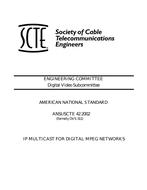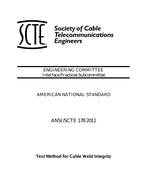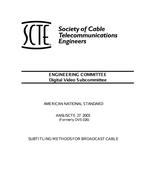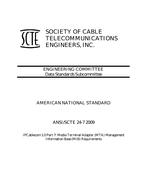Provide PDF Format
SCTE 58 2003
- AM Cross Modulation Measurements, (formerly IPS TP 208)
- standard by Society of Cable Telecommunication Engineers, 01/01/2003
- Publisher: SCTE
$25.00$50.00
This document describes a test procedure for the laboratory and production measurementof Amplitude Modulation Cross Modulation (or AM-XMOD) that is present in BroadbandSystems which carry Frequency Division Multiplexed (FDM), amplitude modulated,analog video channels. In general there are two components to the cross modulationgenerated in such systems; namely, cross modulation of the direct Amplitude Modulation(AM-XMOD) type and cross modulation of the less obvious Phase Modulation (PMXMOD)type. In the past, the PM-XMOD component was not directly considered, for manypertinent reasons. With the advent of larger cable telecommunications systems (e.g. morevideo channels with carrier placement at higher frequencies), and the implementation ofdifferent equipment and technology (such as fiber optics in the distribution path), it hasbecome necessary that the PM-XMOD at least be described. The physical processes bywhich the two components of cross modulation are generated have some fundamentaldifferences. However, the resultant video impairment to the viewer can be the same if theproper conditions exist. (That is, both of these components have been shown to causesimilar visual disturbances in the desired picture when the proper conditions exist andhence are considered to be true impairments.) The issue of how each component of crossmodulation is detected at the subscriber's terminal (i.e. "set-top receiver") and thesubsequent perceptibility levels that should be specified will NOT be addressed in thisdocument.The procedure described in this document for measuring the 'AM-XMOD DistortionRatio' uses an RF Receiver, to detect the modulation, and a Baseband Analyzer, tomeasure the detected modulation signal levels. The test method, as given, is meant tomitigate the effects that PM-XMOD has upon the accurate detection of AM-XMOD. Acommon alternative to this measurement technique is to measure the AM-XMOD using aspecific instrument, namely the 'Spectrum Analyzer'. The Spectrum Analyzer has thecapability to both detect and measure the magnitude of the modulation level (i.e. the levelsof the sidebands) in the frequency domain. An AM-XMOD measurement that uses this"frequency domain" technique will be different from a measurement made using thetechnique described in this procedure, because the Spectrum Analyzer can not discriminateAM and PM sidebands. The type of detector used in the RF Receiver, as well as themethod of detection used in the Baseband Analyzer to measure the sideband energy of themodulation, will be specified.The detectors used in the RF Receiver and the Baseband Analyzer instruments are differentthan those used in a typical Spectrum Analyzer. Therefore, a Spectrum Analyzer, whereused in this document, is understood to be a separate instrument from either an RFReceiver or a Baseband Analyzer. However, it is generally understood that a SpectrumAnalyzer can be used as a receiver instrument, whereby either the IF output is taken and RFdemodulation is accomplished externally by a separate detector, or the SpectrumAnalyzer's (Linear) demodulator is used. In either approach, after demodulation, aBaseband Analyzer then detects the video modulation.
Related Products
SCTE 24-20 2005
Requirements for Preferential Telecommunications over IPCablecom Networks..
$25.00 $50.00
SCTE 24-7 2009
IPCablecom Part 7: Media Terminal Adapter (MTA) Management Information Base (MIB) Requirements..
$25.00 $50.00





